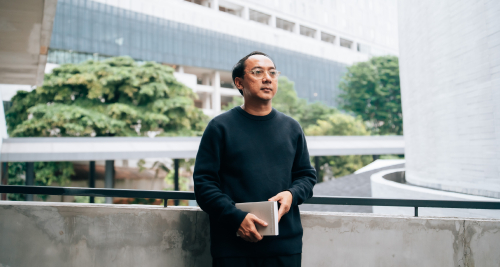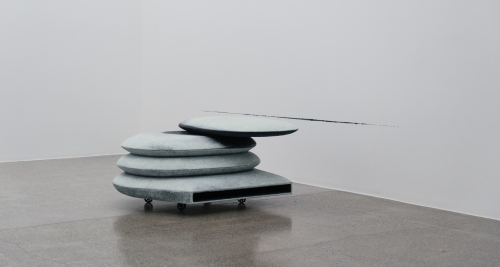The Journey towards a Truly Sustainable Design Industry with Edo Girardi of Potato Head
With this year’s International Design Day’s theme being Is It Kind?, it’s crucial for practitioners to tackle one of the biggest challenges facing the industry today—sustainability. The International Council of Design clarifies the theme on their official website writing, “Defining kind design and building kindness into design practice means: Centering humanity.” In centering humanity and kindness, practitioners in the design industry must seriously reexamine how we have implemented and valued sustainability in their practice and how much further we have to go. Truly sustainable design should be able to provide long-term solutions to the betterment of all parties the design impacts, including but not limited to the environment. There have been notable developments from various players of the design industry like the Kickyourbutt project which creates alternative materials from cigarette butts, and NStudio’s collaboration with Alner, but we still have some way to go to actualize a truly sustainable design industry. To delve deep into the issue, Grafis Masa Kini sat down with Edo Girardi, Creative Studio Manager at Potato Head Bali, which was granted their B Corporation Certification just last year at a score of 81.7.
In Edo’s view, sustainable design is a design and artworking process that considers its impact on sustainability both in terms of those directly affected, such as the clients, users, and the designers themselves, as well as the greater impact on the public, the environments, and specifically, on the ecosystem in which the design is placed or implemented. “In the context and relevance with graphic design, sustainable graphic design can be seen through the entirety of the creative creation process; material selection, the creative process, the cycle of work, and its positive impact on the environment and society. If we were in a utopia, I consider sustainable design as a design that is outputting fewer variants, quantity, process—straightforward, purpose-driven, impactful in better function, positive quality, and good for common people; design that is humanizing humans,” Edo explained.
As a hospitality brand, Potato Head orients itself to their motto “Good Times, Do Good” and places sustainability as its anchor. This commitment is not merely lip service. “Potato Head is the only hotel in the Seminyak, Bali area that has an in-house Waste Management and Waste Lab under the management of the Sustainability Department, here we have dedicated ‘Green Team’ to choose, sort, and process waste and garbage that we produce—even experiment with the waste and garbage produced at the hotel as a medium. The amenities and furniture that you see at Potato Head are mostly the creations of designers and craftsmen from the Waste Lab who collaborate with both local and international designers,” Edo elaborated. Additionally, they also hold programs including their ‘Morning Waste Tour’, where hotel guests are invited to see how all the rubbish and waste are processed, workshops like ‘Sustainable Products’ organized by the Green Team, and ‘Sunset Clean-up’ where guests take part in collecting waste at Petitenget Beach to later be processed at Potato Head’s Waste Management. “We don’t only open the above facilities and programs to guests but also to the public, because we believe that good initiatives and knowledge for the better is meant to be shared—by sharing this knowledge, we hope it can be a good experience, and in the end it can be adapted as a sustainable lifestyle.”
Potato Head’s B Corporation certification is an acknowledgement of how effective the steps Potato Head has taken, and is continuing to take, towards sustainability. “This certification was achieved due to the efforts and hard work of the Potato Head team, especially the Sustainability Team who tirelessly managed to lead, organize and protect the Potato Head team as a whole in the global movement towards inclusive and regenerative sustainability programs. Of course, this success is a good guideline for the future, not only in the context of hospitality companies, but also repositioning Potato Head as a global regenerative brand that is empowering its ecosystem, environment, and its people,” Edo noted.
While Potato Head has made great strides and is a clear pioneer in championing sustainable design, many players still struggle with effectively implementing sustainability in their practice. In Edo’s perspective this can be attributed to three main factors; the practice not aligning with the issue of sustainability, variables and stakeholders of a project not seeing eye-to-eye on sustainability consciousness, and finally, the lack of a consistent metric in regards to sustainable design. In regards to the practice not aligning with sustainability, Edo specifies that this can also refer to the impact of the project having significant distance with the practice itself. “For example, web developers and publishing design, of course the level of intersection is different from one another. The impact of a web designer or developer's practices does not necessarily have a direct interaction with eco-sustainability, in contrast to book designers who have to directly deal with raw materials, calculate the number of pages to be produced, evaluate the amount of rubbish and waste that will be produced. However, that doesn't mean that the pursuit of web designers/developers is more ‘noble.’ Let's try using the same premise of ‘awareness of the direct impact is too far away to be felt directly'—in that scenari, we should be able to calculate how much internet quota a web designer/developer spends in completing a project? Internet networks require extraordinary electrical power, and unfortunately all the electrical power (in Indonesia) that we use still uses fossil fuels whose carbon footprint is no joke! So unfortunately, we all share the same sin,” Edo elaborated.
In regards to variables and stakeholders in the design practice not operating on the same level of sustainable consciousness, Edo points towards the sheer number of parties involved in the project. “Approximately how many people participate in the creative process? How many clients take part in the decision-making? Does everyone have the same level of sustainability consciousness? It still feels quite challenging to find a common consensus to move towards sustainable design practice as long as the project is still profit-centric,” Edo remarked. He continued to explain that in his decade-long career, the stakeholders of design projects still orient themselves to three tenets; cheap, good, and fast. There is still a lack of projects that commit themselves to the crucial fourth tenet; sustainability. There is also still the matter of the lack of a reliable and constant metric of sustainability in design. “[There is still] no tool to measure sustainability effectively in the design practice. The measuring tool that I mean here is a medium, body, or institution that is able to measure, evaluate, and certify whether a design project produced meets the sustainable design corridor,” Edo clarified. “Maybe in the near future; ADGI can issue certification or awarding systems (or competitions) for all brands and graphic works in Indonesia. What is hoped is that all designers can work with a higher level of sustainability consciousness. In a perfect world, maybe an official validation system at the level of something like the Cap Halal for sustainable design work,” Edo suggested.

ADGI acknowledges that sustainability is a key issue that the design industry is facing and has made some steps in the right direction. “Sustainability is an important point in design ethics, here we invite professional graphic designers to be able to provide appropriate education about sustainability to recipients of their services.” Ritchie Ned Hansel, Chairman of ADGI remarked. “How to use environmentally friendly materials for packaging, create public service campaigns that have a real impact, and how design businesses can be healthy by avoiding speculative work practices.”
Muhammad Imaduddin, Secretary General of ADGI noted that in the seminars and workshops they’ve held, they have invited and worked together with many speakers and sources with recycled packaging material manufacturers who use seaweed as an alternative to paper or card. “In 2024, ADGI will also be active and participate in Asia Package Design (APD), a packaging design conference and competition which this year will be located in Seoul, South Korea. At the end of 2023, we and the APD team visited various recycling facilities and sustainability centers in Seoul to learn a lot about sustainability, so that we encourage participants from Indonesia who will compete this year to prioritize aspects of better environmental impact and the use of environmentally friendly materials.” Muhammad explained.
These are commendable first steps but it’s clear that we still have a long road ahead of us and there are small steps all designers can take into consideration. A quick word of advice Edo has imparted as a first step to move in the right direction towards sustainability is to simply “stop over-producing and stop over-designing,” referring to the prevalence of gimmicky design that is overly complex, with features that is often not relevant to the context of the bigger picture. The design industry in Indonesia still struggles between mere greenwashing and real sustainability. Edo surmised, “Reflecting on my experience and several factors from the discussion above, it seems that the Indonesian design ecosystem is still not effective [in implementing sustainability]. Sustainability is still just a temporary, ‘sexy’ issue that has not been addressed as brand values and or design values.”






















